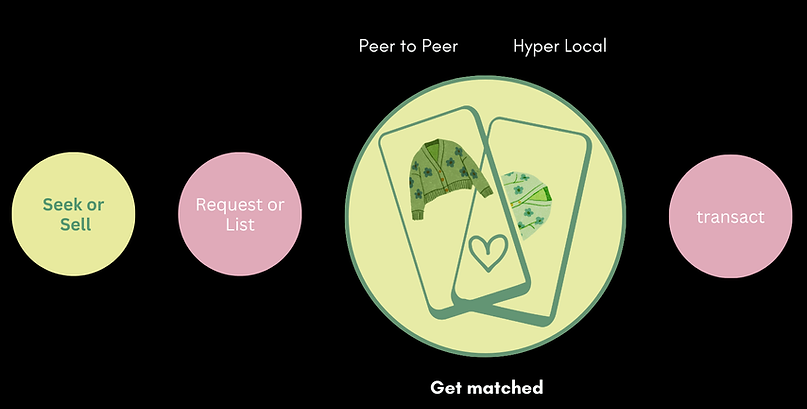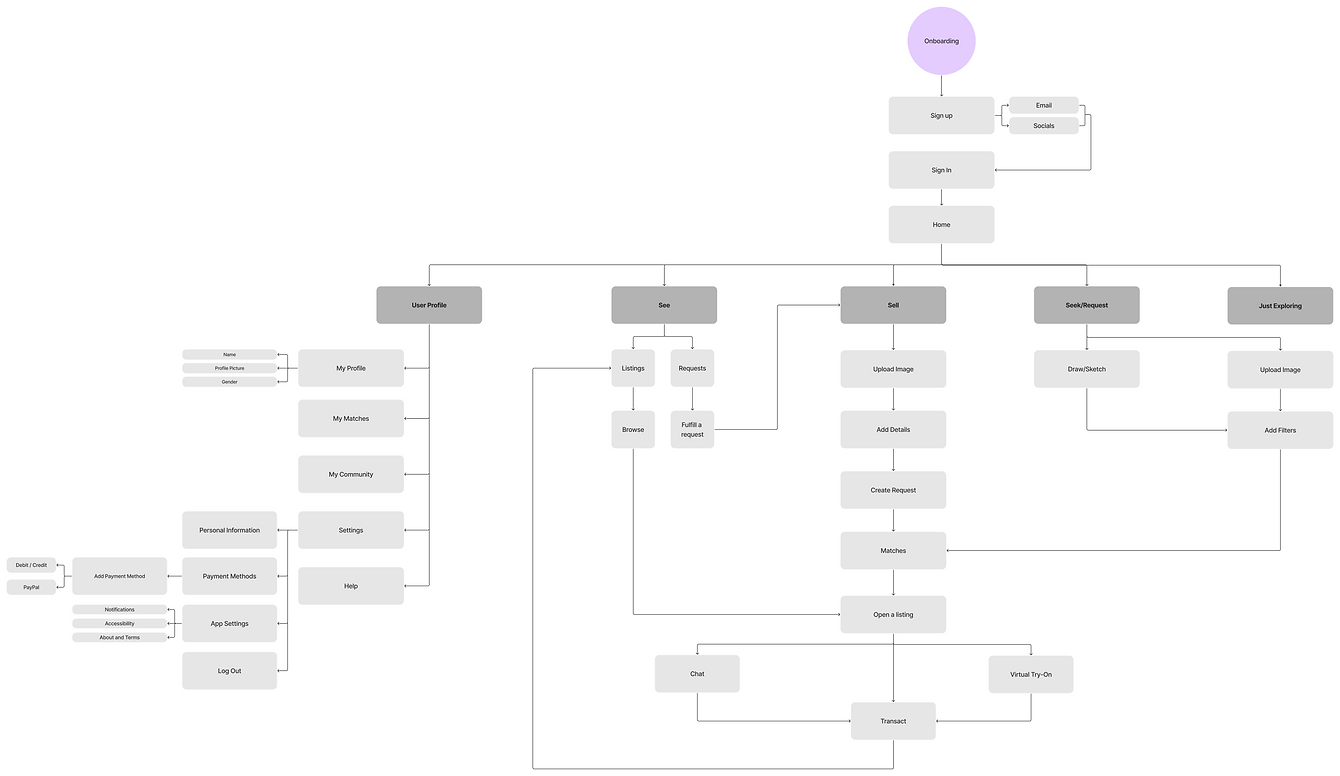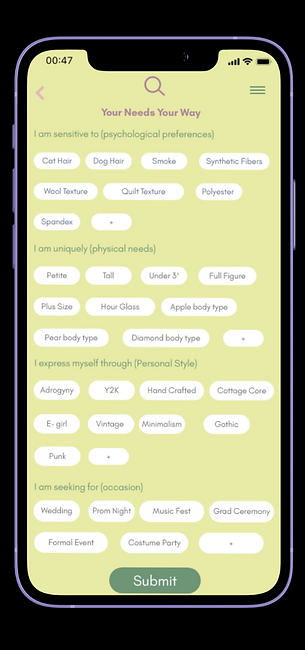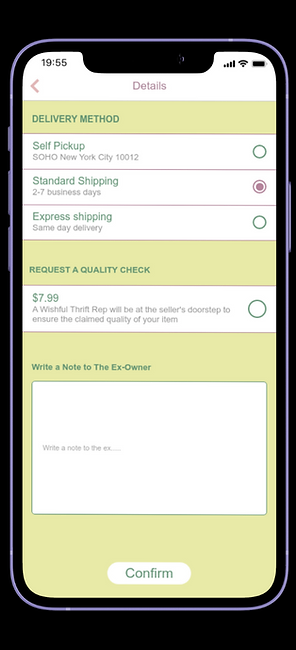
Collaborative Group Project
Bhumika Keswani, Kavita Mishra, Tanmayi Deshmukh
Design Strategy Capstone Studio
Wishful Thrift is a Hyper-local, Peer-to-peer fashion re-selling platform that makes thrifting as convenient as possible.
About
Continuation of
User Research
UX + UI Design
User Testing
Lo-fi Prototyping
Year
2024
Duration
4 Months
Role
Design Strategist and Researcher
Target Audience
-
Thrifters who are trying to bridge the Action-Intention Gap
-
Designers
-
Upcyclers
-
Brands
-
NGOs
Limitations
-
Time: 6 months of concept, prototyping, testing and design
-
Users: Limited number of users for testing
Objectives
Increase Convenience in Thrifting
Enhance the ease and accessibility of thrifting and second-hand shopping to bridge the intention-action gap in adopting sustainable fashion practices.
Personalized Experience
Develop features like personalized filters, robust search tools, and matching percentages to tailor the shopping experience to individual needs
Environmental and Social Impact
Promote the positive impact of small shifts in consuming habits on society and the planet, encouraging responsible and sustainable fashion consumption .
Process at a glance

Outcome
Peer-to-peer fashion re-selling platform.
Match with your perfect thrift


In-depth Process
Relevance and Need
Currently

People list
what they want to sell.
Others see these listings.
They buy whatever best they can find.

With Wishful Thrift
People request
what they are seeking.
Others see this and offer.
They buy actually what they need.
Our Motivation
Between 2000 and 2015,
8%
2X
annual clothing production and sales doubled...
1/2
number of wears has halved.
American consumers affected by compulsive buying disorders
The Action-Intention Gap
A frustrating Paradox
65%
consumers say they want to buy purpose-driven brands that advocate sustainability...
26%
...actually do so.
Although shopping second-hand & thrifting can seem like an enticing and straightforward shopping experience, several obstacles hinder its widespread adoption.
Our Process
Target Audience and their pain points

Lack of-
Convenience.
Insights Gathering through-
20+
20+
12+
Literature Reviews
User Interviews
Expert Interviews
6
5
11
Testing Workshop Participants
Digital Ethnographies on various shopping platforms
Shadowing and observing Stores
Stakeholder Mapping
We mapped out the primary, secondary, and tertiary stakeholders to better understand the interconnections and interdependencies between the parts of the fashion reselling system.

16+
Stakeholder Interviews
80
Survey Responses
Stakeholder Interviews
In-depth interviews were conducted with various stakeholders, to understand needs, gain points, and areas of opportunities.

Sustainability Groups
Subject Matter Experts
Local Thrift Stores
Small Upcycling Brands
Thrifting Consumers

What informed our decisions?
What the Stakeholders
loved
didn't
Thrift Stores, Designers
This will definitely save time and effort of searching.
Upcycling artists and designers benefit from sourcing and reselling.
Community interaction fosters trust and connection.
Thrift Stores
Thrift stores lack inventory management for digital presence.
Digitizing inventory is
time-consuming compared to sales benefits.
Maintaining this would require additional store resources.
Thrift Stores did not need our intervention.
But digital re-selling platforms could.
Finding the Opportunity
Unmet Needs of the User

Pain Point Identification
Need for an easy way to find with curated ask
Need to be sure of availability, quality and safety
Need to connect with right kind of community for thrifting
Defining our Key Pillars
Seek>Search
Assurance
Peer to Peer
Instead of settling with whats out there, curate the ask.
Being sure of the right find.
Transact, learn and grow with hyper-local community of like-hearted thrifters.
Landscape Analysis
To recognize the competitors and the market, we mapped out the competitors and peers of Wishful Thrift in the fashion reselling landscape.


Testing
The prototype was tested over the span of 2 weeks with various stakeholders to understand themes, insights, and areas of improvement.
The key features were refined through testing, ensuring they meet our users' needs effectively.


The Design


Information Architecture


Lo-fi Prototype and User-Journey
Olive's User Journey
Pillar 1
Seek>Search
Instead of settling with whats out there, curate the ask.

Doodle Feature

Robust Search Tool

Finite Scrolling
Personalized filters
Matching Percentage
Pillar 2
Assurance
Being sure of the right find.



Honest defect reveal
Wishful Thrift quality check
Self Impact awareness
Verifed, Trusted sellers
Virtual try on
Pillar 3
Peer to Peer
Transact, learn and grow with hyper-local community of like-hearted thrifters.



Find your own community
Match with curated wardobe
See other's requests and offer
Send notes to the ex - owner
Roadmap
Value Generation through Circular Model

Roadmap
Way Forward
Business Model Testing


